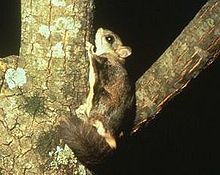
Back سنجاب طائر Arabic سنجاب طائر ARZ Палятухавыя Byelorussian Палятухі BE-X-OLD Летящи катерици Bulgarian བྱ་མ་བྱི། Tibetan Gwiñver-nij Breton Esquirols voladors Catalan Gleithörnchen German Tompin DTP
| Flying squirrel Temporal range: Early Oligocene – Recent
| |
|---|---|

| |
| Northern flying squirrel (Glaucomys sabrinus) | |
| Scientific classification | |
| Domain: | Eukaryota |
| Kingdom: | Animalia |
| Phylum: | Chordata |
| Class: | Mammalia |
| Order: | Rodentia |
| Family: | Sciuridae |
| Subfamily: | Sciurinae |
| Tribe: | Pteromyini Brandt, 1855 |
| Genera | |
|
Aeretes | |
Flying squirrels (scientifically known as Pteromyini or Petauristini) are a tribe of 50 species of squirrels in the family Sciuridae. Despite their name, they are not in fact capable of full flight in the same way as birds or bats, but they are able to glide from one tree to another with the aid of a patagium, a furred skin membrane that stretches from wrist to ankle. Their long tails also provide stability as they glide.[1] Anatomically they are very similar to other squirrels with a number of adaptations to suit their lifestyle; their limb bones are longer and their hand bones, foot bones, and distal vertebrae are shorter. Flying squirrels are able to steer and exert control over their glide path with their limbs and tail.
Molecular studies have shown that flying squirrels are monophyletic (of one phylum/ clade with no branching within the phylum) and originated some 18–20 million years ago. The genus Paracitellus is the earliest lineage to the flying squirrel dating back to the late Oligocene era.[1] Most are nocturnal and omnivorous, eating fruit, seeds, buds, flowers, insects, gastropods, spiders, fungi, bird's eggs, tree sap and young birds. The young are born in a nest and are at first naked and helpless. They are cared for by their mother and by five weeks are able to practice gliding skills so that by ten weeks they are ready to leave the nest.
Some captive-bred southern flying squirrels have become domesticated as small household pets, a type of "pocket pet".[2]
- ^ a b Lu, Xuefei (24 June 2012). "The Evolution and Paleobiogeography of Flying Squirrels (Sciuridae, Pteromyini) in Response to Global Environmental Change". Evolutionary Biology. 40 (40): 117–132. doi:10.1007/s11692-012-9191-6. S2CID 15742612. Retrieved 28 October 2021.
- ^ "Do Southern Flying Squirrels make Good Pets to Keep?". petcaretips.net. Retrieved 2018-02-23.